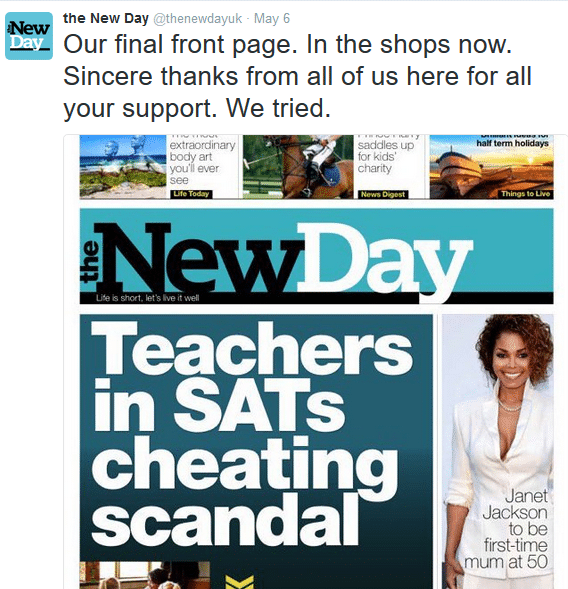Easy come, easy go. That’s what the publisher of Trinity Mirror is saying about its nine-week experiment with print-only tabloid, New Day, that launched earlier this year. After lackluster sales, the Trinity Mirror shut down New Day last Friday, reports the BBC.

New Day was the first standalone national daily newspaper in the U.K. in 30 years. Targeting readers between the ages of 35 and 55, New Day was intended to be an upbeat, optimistic, politically-neutral weekday tabloid. It served up bite-sized, digest-style news to “time-poor” readers.
On February 29, the newspaper’s launch day, 2 million free copies of the 40-page stapled tabloid were available at more than 40,000 retailers. For the next two weeks, it was offered for 25 pence ($0.36 U.S.), before going up to 50 pence ($0.72).
A key differentiating factor was that New Day was truly a standalone publication. It was not designed to be a sister publication to the Daily Mirror, and it had no web or app component. New Day did have a social media presence, but it wasn’t around long enough to grow a strong audience. For example, as of today, New Day’s Twitter account (@thenewdayuk) had made 650 tweets, was following 42 accounts and had 13,000 followers.
So what went wrong? Everything. From the basic premise of a print-only publication to counting on daily newsstand sales of 200,000, New Day was doomed from the start. It bucked the industry-wide decline of print circulation and ignored the growing trend toward consuming news online or via an app of some kind. Without subscription sales or home delivery, New Day was dependent on strong newsstand sales which, quite simply, didn’t happen.
After 50 issues, New Day is no more, and the majority of the newspaper’s staff will lose their jobs, reports the BBC. Some positions will, however, be absorbed by the Mirror.
Editor Alison Phillips said they tried everything they could to make a go of the publication.
“The response over the 50 issues we have published has been extraordinary,” she said. “I have never worked on a title with such engagement from readers. There clearly were many people who truly loved the idea of a different kind of newspaper which spoke to them. But the reality was we didn’t have enough of them on a daily basis.”
Insider Take:
This idea was flawed from the outset. While there may be a market for print publications, the reality is that digital is growing. If New Day had considered any sort of web presence, it may have been more successful. For example, while New Day had a Twitter account, it had nowhere to steer consumers where to read stories online. They could only steer them toward newsstands. By the time they would leave their homes or offices to buy a copy, they could have find similar news – often for free – online somewhere.
In addition, it is hard to imagine that New Day launched without having some sort of subscription component or a membership program to provide some level of regular, reliable source of recurring revenue is counterintuitive. They were banking on a narrow audience going against the growing digital news trend to go pick up and purchase a newspaper every day. That could have worked if they hadn’t gone “all in” on print. A multi-level revenue strategy would have been much smarter.
It’s not all bad news though. First of all, they took a chance. They thought outside the box to create a somewhat innovative product with a clearly defined target audience. They took a risk, and risks don’t always pay off. Secondly, they bailed early. Rather than continue to put out a losing newspaper, they dumped the entire experiment. From a financial perspective, while unfortunate, it was smart.
Hard lessons learned.








